jrice
Wanaka
It’s Saturday March 28th. We woke up this morning here in Wanaka to the sight of the rising sun illuminating the peaks across the lake from our room. The mountain tops were bright golden above the green grassy slopes below. The tops are too high for anything more than low beige grasses and cold-proof vegetation to grow on.

(early morning, Wanaka. The park begins across the street from our room. The trail goes either direction from here)
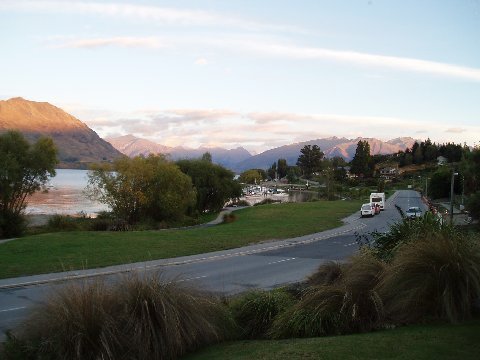
(those mountains in the background are waaaay far away!)
The lake was relatively smooth this morning and the ducks were out enjoying it. I walked the short distance across the park into town to pick up morning pastries for breakfast. The bakery were I sought something for Brenda had warm sultana scones just out of the oven. In the parking area for the small lakeside park a station wagon full of young people were just coming to life after having slept in their car the night before. A tall young woman stood beside the car, rubbing her eyes, while inside, a tangle of indistinct bodies and sleeping bags was stirring like a basket of puppies trying to wake up. Back in our room Brenda had pastry and coffee in bed while I worked on the computer handling what I could from my office, where it was just after lunch yesterday. Soon however 3 or 4 of the ducks from the lake had wandered up to our sliding glass door demanding their expected payment for being cute. We of course complied.
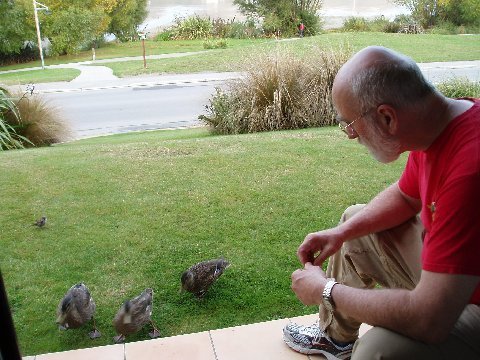
("Come across with the pastry kiddo, and nobody gets hurt, see". We've got beaks and we know how to use them")
Later in the morning we sat out for the walk on the travel path around our side of the lake. We saw a group of children preparing to take off in small sailboats, apparently being instructed by some men in the art of sailing. Like all young boys, they were more interested in testing the limits of the craft in motion, spinning around in the tightest turns possible, than in accuracy. The trail goes to a camping area called Eely Point. The views of course are indescribable in my poor vocabulary. People may find it strange when they ask what we did in a tourist area like Wanaka, when we say “we walked” but I can’t think of any better way to see this gorgeous country. It also occurs to be for most people who go on vacations to do something at a place, they spend their time traveling to get to a thing they are going to do. When we travel by motorcycle however we are doing the thing we want to do as soon as we leave the parking area. We are doing our activity all the time, not just when we arrive somewhere. We saw ads for rafting, jet boating and bungie jumping but we’ve already had our excitement just getting here. We are now content to walk these quiet forested paths with the beautiful aftermath of nature’s power in our view at all times. Storms damage a relatively wide area by human standards, but nature’s wind is temporary and limited in scope. A tornado may tear up a swath of buildings or blow down some of man’s other constructions, but a glacier rearranges mountains, creates lakes that go for miles and flattens out areas the size of major cities.
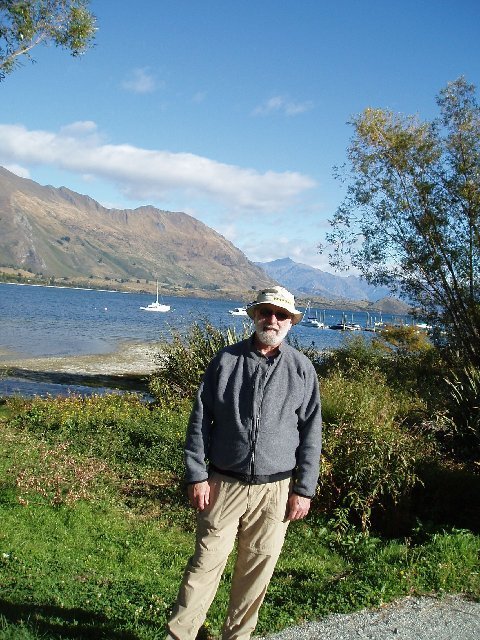
(this would be "the old man of the sea", but it's a lake and the "old man of the lake" just doesn't have the same ring to it.)

(same old man, same lake, farther along)
We stayed two days at Wanaka, a town we both loved from our first night here a couple of weeks ago. I went for a solo ride while Brenda stayed behind for some quiet time in town. I thought I’d go explore the road around the west side of the lake going toward the mountains we could see rising in the distance. This road quickly leaves the lakeside and twists off into the foothills (read “mountains” in Eastern Ky terms) rising and falling in perfectly radiused turns as if designed by a motorcyclist. Since it follows the curve of the hills, one could ponder just how sympathetic Ma Nature is to our needs after all. The mountains take a long time to seem any closer, an indication of just how doggone big they are. I finally realize that I’m not actually going to get there if I have any chance of getting back to Wanaka before suppertime and, as has been a constant feature of this trip, my stomach won out and I turned around.
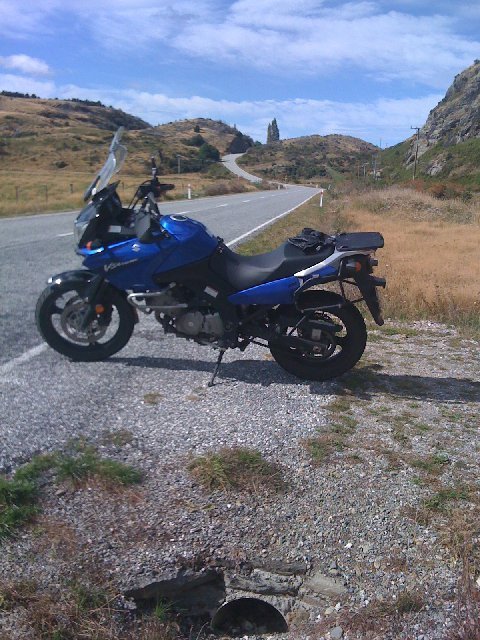
(and it goes on this way for miles and miles....)
One of the things that I have neglected to mention so far is the number of one-lane bridges in New Zealand. I guess it makes engineering sense in that you only have to build a bridge one-half as strong since it will never have two lanes of traffic on it. The system seems to work rather well when there are so few cars on the road. One comes to a set of lane markings that tell you a one lane bridge is coming up and there is a round sign with two arrows pointing in opposite directions, one larger and a different color than the other. If the larger colored arrow is pointing in your direction of travel, you have the right of way and if it’s the smaller arrow then you must yield to someone coming through the other way. Everyone seems to understand the system and it works well except when the bridge is around a blind curve and you don’t see it coming until you are already on top of it!
When one is only used to traveling by car, the view of the world framed by a windshield and hardtop becomes the “normal” one, the frame (literally) of reference for how the world in motion looks. Even in a convertible automobile with the top down, the driver is held in one spot, level to the horizon, front view still constricted by the windshield frame, side and downward view limited by the car’s bodywork. When I talk about what I see, what I experience, from a bike to someone who’s never been there, I can tell that they have no reference point for understanding what I’m trying to impart. Kurt Vonnegut once wrote in parable about the Tralfamadorian’s, an alien race whose experience of time was not like humans. In trying to explain it, he likened the human experience of time to a man seated rigidly on a railroad car with his head encased in a turret, immobile, with his view only forward, only of what visible out of the gunbarrel-like tube extending from the turret. The railroad car could only go in one direction and the man could see “time” as what unfolded through the barrel’s aperture as the car moved inexorably forward. The Tralfamadorians, in contrast, were above the plain upon which the track ran and could see everything around it, forward, backward and on all sides, at once. While a motorcycle doesn’t afford quite that degree of omniscience, it is an improvement of the same kind, if not degree, over the car experience.
Counting down the days too quickly
We gave the Catlins short shrift, I fear, after we found that the beachfront areas could only be reached by gravel roads. The paved road through the area was pretty enough, with low hills and lots of curves and quite a few places where the ocean suddenly came into view as the bike rounded a hillside. (Again, the ocean with completely undeveloped coastline.) We stopped for our mid-morning snack at the “Whistling Frog” café, part of a “holiday park” which catered to camper vans and small camping trailers which are ubiquitous here in New Zealand. We spoke to the manager of the place (and the farm which was part of the same operation) who told us that this had been their best year for quite some time. The weather had been good for farming (i.e. wet) and the tourist trade from Europe, the Orient and the US had increased dramatically. The favorable NZ dollar rate has made it a very popular destination.

(we didn't actually hear any frogs whistling, but it is fun trying to picture how they'd look doing it)
By the time we left the café, the rain had picked up again and the ever-present wind was beginning to become bothersome at times. I missed a turn at the beachfront area of Fortrose (at least there was a road shown on the map which I never saw on the ground….it might have been gravel and unmarked ) and we ended up going on into Invercargill, where, due no doubt to an oversight on the part of the New Zealand tourism commission, there is no center-of-town monument to Burt Munro, and his garage, with its Offerings to the Gods of Speed is not one of the places marked as a “must see”. We did come into town through neighborhoods that looked just like the one in the movie portrayed as his. Lunch was at an old hotel café where we were served by a pleasant young woman who told us she was from TeAnou. When I asked her why she had left such a pretty place to come to an industrial city, she said “because I’ve lived there all my life”. She said she’d probably go back when she got older. It’s the universal human urge to go “somewhere else” and see what’s over the next horizon. As we left town, on roads I’m sure Burt traversed on his Indian, the wind and rain resumed, making travel rather slow. We had decided to go north again, to pick up in our last days here a few of the favorite places we’d visited before. Our leash was growing short, the bike has to be turned in on the 30th, so we can’t get too far out of range of Dunedin. We headed for Wanaka, but made it only as far as Roxburgh that night. As we came back into the mountains of Central Otago, both of noted that this seemed to be the area we most liked. The scenery is still mind-blowing, but not so overwhelming as the craggy mountains of the West Coast where nature isn’t quite as far along in her softening process. Here in Otago, the high hills are again covered in limestone-looking outcroppings and the valleys are deep, with the landscape at times looking like Ireland, other times the north of Yorkshire in England and others, Bavaria. It’s easy to see why peoples from all over the world have come here to settle…for an awful lot of them, it looks like home. At Roxburgh, we found a small motel off the main road, with an unusual parking arrangement. Each unit has its own “garage”, a secluded covered parking area lacking only an outer door to be fully enclosed.

(Even for NZ, a motorcycle-friendly place if ever there was one, this is exceptional)
Inside the unit, there was a bedroom separate from a kitchen/living room, more than adequate for staying extended periods of time. And all this for about US $45. We asked the proprietor about getting a meal. He called the local hotel (here in NZ, “hotel” usually means a combination of pub and restaurant, not always or even typically with any lodging function) and gave us directions to it, just around the corner. When we got there, the publican escorted us back into the dining room which was normally closed for the evening, but opened just for us. He and his wife catered to us in our “private” dining room, with an excellent meal, local beer and wine and charged us the princely sum of about $40 US for the experience. When we expressed our gratitude for such service he replied “We do this all the time”. As I said earlier, this country is set up for people who travel.

The old hotel with the marvelously personal dining service
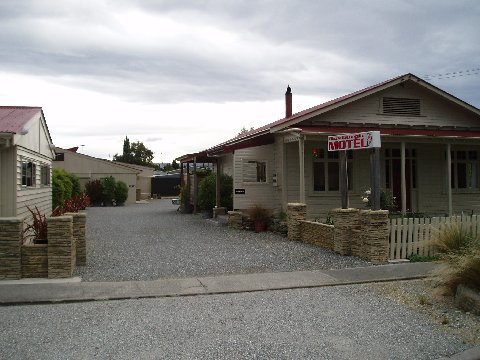
The Roxburgh Motel
The next morning we left Roxburgh headed north, feeling the pressure of time running out. It’s only a short run from there to Clyde, the small town where we’d spent our first night on the road. We wanted to have “elevenses” (a charming English custom of having a snack at 11 AM, to tide one over til lunch) at our favorite café there. We arrived just about on time, parked in front of the café and strolled over to the outside tables. An older lady sat at one with her morning paper, coffee & pastry and a Border Collie under the bench. The dog, as is typical of her breed, seemed eager but too well trained to do anything out of order. With the owner’s permission I began the pet the animal who let me know that this was exactly the right thing to do. The owner laughed and told me I’d get tired of doing it long before the dog would. She was right. We (Brenda and I, not the dog) went into the café and were greeted by the owner who recalled us from three weeks earlier. She seemed pleased to see us, as though she expected us back like locals. We sat outside on the street, enjoying our wonderful breakfast plates (these folks really understand the concept of breakfast, in my book) and just soaking up as much of the flavor of the town as we could.

(Brenda on the sidewalk in front of the cafe in Clyde. The border collie is under the table behind her)
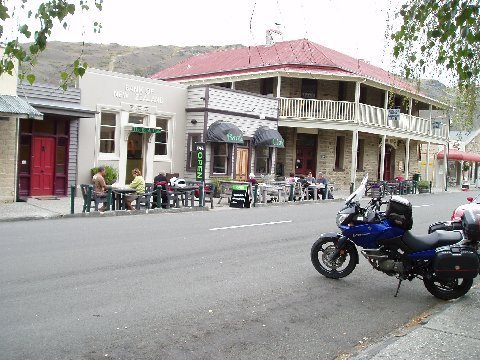
(The cafe across the street is, I think, our favorite of an overall wonderful lot in NZ)
Back on the bike, we made our way up beside Lake Dunstan toward Wanaka This road had amazed both of us three weeks earlier and it hadn’t diminished a bit. As we left Clyde, the road climbs up the side of the mountain on the east side of the lake, high above the water’s surface, then begins to drop in curves down to just above the shore, though “shoreline” isn’t exactly a good description. The side of the road, to my left (I’m in the left lane, remember) ends and then there is a dropoff of sheer rock about 50 feet down to the surface. I can’t spend a lot of time looking around. At Cromwell, the road crosses the lake and heads up the other side, now in low hills bordered by vineyards and orchards. Here the wind picks up in earnest, causing us to slow to 60 or 80 KmPH just to keep the bike on the road. The wind is a constant feature here in New Zealand and it seems to my non-native view, a somewhat unpredictable feature. It often comes from the direction you don’t expect and then sometimes can change direction 180 degrees without warning. Obviously, the farmers here pay attention to it because they erect large windbreaks that we see often from the bike. At a distance these look like an ordinary box hedge such as you would have around your suburban yard, except when you get closer you see they are 40 feet or more high and 20 feet wide, composed of evergreen trees that are planted so close together that the branches intertwine making a solid barrier. What I don’t know is how they trim them into such perfectly box- like shapes. I can’t imagine a set of hedge clippers that size. These windbreaks can be as much a half mile long beside the road or outlining a field like a fence. We often saw herds of sheep or cattle arranged along the base of these, seeking shelter. On the motorcycle the wind can be a problem. We are constantly banking into it as if going around a curve when we are on a straight stretch of road. When it strikes suddenly as when one comes through a canyon, it can almost upset one’s balance. When going into a head wind its like being battered about the head and shoulders. Going along of the sea coast one can see the wind blowing the water up on shore but the prevailing wind that you are fighting is coming from the opposite direction. I’ve come to expect it somewhat, but it always manages to surprise me. The wind died down as the road got further from the water going into Luggate and making the turn up into Wanaka.
Headed south, circle completed
On March 25th, Wednesday morning. I went for a walk from our little beach side cottage up through the village along the road back toward the point. In the dark I could see the lights of the fishing boats going out into the bay. Just as the sun was first beginning to make its light visible I got to the end of the point by Fleur’s restaurant and the beginning of the Millennium Trail.
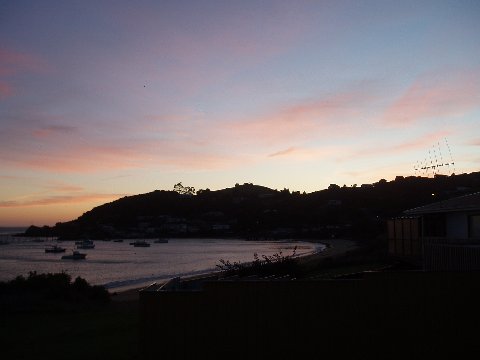
(the sun comes up over Moreraki Point)
This is a walk way which goes around the edge of the point beyond the village. The path winds along the edge of the cliff at the bottom and continues climbing in a series of switchback paths and steps to the top.

(the steps keep going up and up)
I took some detours out on to points of land that jutted out in the bay. I was standing on one of those perhaps about 300 feet above the ocean as the first red rim of the sun peaked above the Pacific.

(I was standing out on this point when the sun came up)
From that point it seemed to rise rather quickly as light filled the sky and it illuminated my path. I climbed on to the top encountering several sheep on the way who seemed mildly curious about my presence. As I got near one group of three they seemed suddenly to just step off the edge into space but in fact they had just gone over a ledge onto a slope that was at least 60 degrees or more. It seemed not to phase them in the least. Finally I got to the top and the Whaler’s Memorial, the monument which commemorates the ancient sailors who stood up here, spyglass at the ready, waiting for the telltale spout of a whale in the distance. From this highest point one can see an arc of about 300 degrees of ocean and all of the village of Moreaki. Since I don’t think the ancient ones had cell phones, I hope they had some communication system to get the word back to the village, By the time they walked back down the hill, the whale would have been in Samoa.
I made my way back down the hill and circled Fleur’s with the camera taking pictures of where we had been the night before. Back at the cabin we packed up our things and backtracked to Moreraki point, the only place where breakfast was available for miles. We were eating there as yet more tour buses pulled in to disgorge their hordes of camera-toting tourists, each looking for the nearest bathroom. I much prefer our way of travel.
From there we headed south again on route 1 going in and out of Pacific views. From Moreraki down to Palmerston where we left route 1 to head into the mountains, the road skirts along the edge of the pacific with again no development visible to the naked eye. It really is like stepping back in time.
At Palmerston we got fuel and headed up into the mountains going northwest into central Otago. We followed ridge lines through the soft brown hills, actually mountains, on sweeping curves that would come around the edge of one hill and open up into a huge valley below with such dramatic change that it’s disorienting for a moment. There are mostly sheep farms here though quite a few cattle as well. The streams in the valley floors are wide and flat with crushed rock sides, again the handiwork of some ancient glacier. The changes in color were subtle but impressive. The browns and greens shaded into each other and just when one got used to the pattern, another curve would reveal something quite different in a rock formation or another valley. We stopped at a little town of Middlemarch which is what passes for a hub in this area. I’m guessing that the town may have had a population around 500. The central Otago rails to trail system is located here and we could see some of the converted railroad track down in the valley. We met some bicyclists as we stopped to look around for a café and they told us there wasn’t one (we found out later that they just hadn’t gone far enough in to town yet) so we went in to the little general store/deli on the corner. The young man running the place was from Seattle, having married a New Zealand girl who didn’t want to live anywhere else. He had a BMW R-80 back in the states and was very interested in the V-Strom as an alternative. I told him I had no complaints about the bike, but he was concerned, being used to Bavarian boxer simplicity, that the valve adjustment ritual would be too difficult. I suggested that a modern bike like this should be treated like a car, just taken to the dealer once a year for service, then forgotten about (except for the chain of course!) until the next time. Even though this was only a small grocery, nonetheless he had quite adequate sandwiches available and desserts that still further added to my waistline.
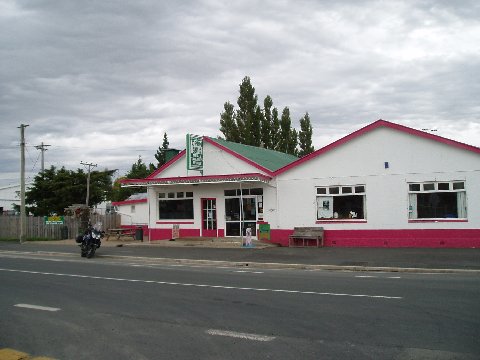
(the general store & deli in Middlemarch)
On the way out of town we find that there was another café just a few blocks down the road, but by now even I couldn’t eat any more. Shortly after leaving town, the terrain changed dramatically again. We were still in relatively low hills but now they were covered in limestone type rock. There were tall stacks of flattened limestone rock looking like the desert formations in the western USA and the fields around them just covered in hummocks of rock. The trials rider in me wanted to go play on them but the sheep probably wouldn’t have been amused. Eventually we came down from this high country back toward the coastal plain. We wanted to avoid the large city so we took a side road that promised to take us to Berwick. This turned out to be a narrow barely paved path which when it reached what should have been Berwick, turned to gravel. Normally gravel roads aren’t any big deal here in New Zealand, we’ve been on several, but this one apparently had just received a fresh coat and the gravel was perhaps 6 inches thick. That combined with a relatively pronounced slope made travel two-up on a heavily laden motorcycle somewhat exciting. Brenda was not happy. We turned around and went back to where Berwick should have been and for the second time in this trip pulled out the GPS we had brought with us. It confirmed that the “Berwick to Henley road” was the small again barely paved track to our left which would take us away from this gravel and toward route 1 headed to the southern area known as the Catlins.
We rejoined Route 1 not far from where we had picked it up in the beginning three weeks ago. We had now completed the circle of the island by going over the same territory headed south toward Milton. This road is gently curved as it crosses the foothills which separate its path from the ocean only a few miles to the east. We could smell the salt air and see the gap behind the mountains that indicated there was nothing there but a broad expanse of water. Just south of Milton we went through the town of Balcultha where we diverted south to the southern scenic route described in our brochure. This was to take us through the Catlins which is a coastal route we thought would follow the water. It turns out not to be quite that scenic. The ocean is several miles away and apparently the small towns are to be reached mainly by gravel roads which Brenda was in no mood to try at this point.. We stopped in the night at Owaka, a town of 300 people which contains several small motels and two full time restaurants. We ate dinner at “The Lumberjack”.
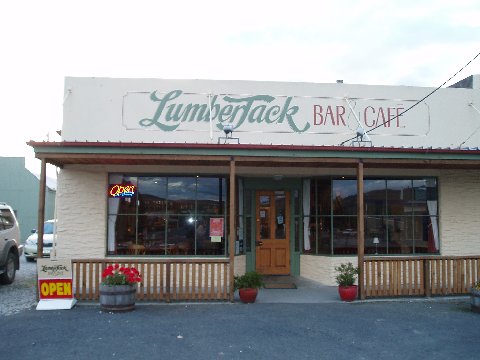
There is a bar at one end made of polished wood with two sets of draft beer taps. On the right is a large stone fireplace with a roaring fire. There are few chairs setting near the fireplace and in these sit customers with glasses of wine. The menu looked like something from a fine restaurant in a big city. We made our selection and ordered a bottle of wine to go with our meal. The food came wonderfully prepared, perfectly seasoned and with pleasing presentation. Such a meal would be proudly served in any of the really nice restaurants in Lexington or Louisville, though this town by population wouldn’t even qualify as a neighborhood in one of those cities.
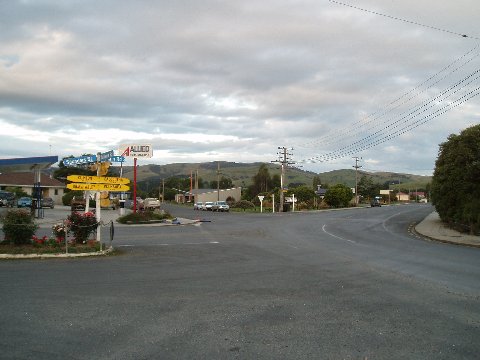
(Main street, center of town, Owaka.)
More random thoughts. Every small town we’ve been in has thriving businesses, locally owned and operated, staffed by workers who are, by American shop-clerk standards, overly friendly and helpful. It occurred to me that one way this is possible is that these local businesses have no health care costs. The local people don’t have to leave the small town and the local shop to go to a bigger city or a chain-store/restaurant company to get health care insurance for themselves and their families. They can stay in their own town. Minimum wage is higher here as well, something around $12 NZ per hour. (As a comparison, the price of an entree in one of these restaurants is about two to two and a half times an hour’s minimum wage. In the US, a similar meal in, for example, a TGI Fridays or Rafferty’s would be about 3 or possibly 4 times an hour’s minimum wage, and it wouldn’t be nearly as good.) With people being able to live and work in the same small town, the towns have a much better-cared-for look. As I write this, I’m in a town of about 300 population that also has two excellent restaurants, a library, a community center and a town swimming pool & park.